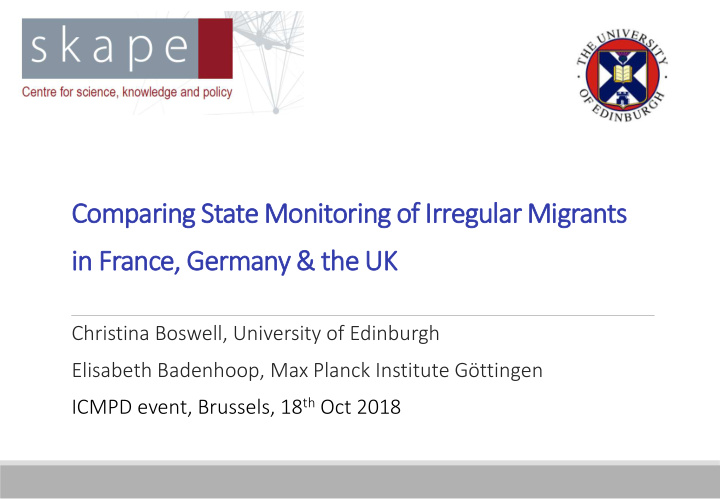



Comparing State Monitoring of Irregular Migrants in France, Germany & the UK Christina Boswell, University of Edinburgh Elisabeth Badenhoop, Max Planck Institute Göttingen ICMPD event, Brussels, 18 th Oct 2018
Nodes of Interaction (a) Border/entry control (b) Registration with public authorities • Police/local authorities • As requirement for work/residence permit • Regularisation programmes • Data-bases (c) Outsourcing to social systems • Employers, carriers, schools, higher education, health, social security, landlords, banks
Implications of different nodes • Migrants’ welfare: • Stage of life/phase in stay at which they interact with authorities? (employment, schooling, healthcare, etc) • Enforcement associated with the node (exclusion, regularisation, detention/removal) • Deterrence effects, exploitation and vulnerability • Immigration control: • Inadvertent effects of monitoring/control
Germany • Reliance on registration and spot checks • Compulsory registration for residence and work permit, renewable • Spot checks of ID • Central Foreigners’ Register • Outsourcing • Robust employer sanctions (since 1972, more robust in 2000s) • 1990 legislation obliging public authorities to report irregular migrants • Limited enforcement of other outsourcing (e.g. School exemption in 2011) Authorities are confident in robust immigration control
France • Regularisation programmes • No post-entry registration system, but frequent regularisations • Since 2000s, more regular police ID checks on streets, leading to rise in detention • Limited outsourcing • Irregular migrants have separate welfare regime (and excluded from social and housing benefits since 1970s) • Attempt at school exclusion in 2000s, but strongly opposed • No formal outsourcing to banks, education or housing More accommodating of irregular migrants – policies recognise as structural problem
UK • Traditional reliance on border control • No internal checks or registration related to residence • Focus is on activities…. • Outsourcing • Employer and carrier sanctions since 1980/90s • HEI and employer sponsorship system since 2008 • Successive rolling out of checks since 2010s – landlords, banks, education, health Strong political message on control – but patchy enforcement. Symbolic policy?
Implications for migrants’ welfare • Deterrence effects of all systems can create more vulnerability • Registration/spot checks can be intrusive and discriminatory • Outsourcing can generate discrimination re access to services • Outsourcing can result in migrants being ‘caught’ far into their stay • E.g. Windrush Generation – identified through access to health, housing, social security • New forms of monitoring can create problems for those who entered under more accommodating system • E.g. Windrush, potentially EEA nationals in the UK
Implications for enforcement • Inadvertent effects of monitoring/control • Driving people underground • Depriving migrants of key services and rights (education, health, housing) • Impeding integration • Creating unmanageable expectations re detention and removal – apprehension does not always lead to return • But: trade-off between more accommodating systems, and immigration control goals?
Recommendations? • Outsourcing should focus on employment • Backed up with enforcement of labour standards • Avoid nodes that ‘catch’ migrants later on in their stay • Registration/documentation is not necessarily negative • Can help clarify status, and protect those legally resident – front-loading checks • Regularisation addresses challenges of migrants’ rights and enforcement – but needs to be designed to avoid ‘pull’ effect • States should accommodate structural persistence of irregular migration!
Zooming in on the German case: evolution of robust monitoring • Three key elements of monitoring: • Individual documentation • Authorities’ cooperation duties • Databases • The Central Foreigners’ Register ( Ausländerzentralregister, AZR ) • Created in 1953 as merger database • Automatized in 1967 • Contains 26 million records accessed by over 14,000 authorities today => Attempt at “seeing” all foreigners who live in, or come through, Germany
The AZR and recent inflows of migrants • The counts don’t match: • AZR: over 10 million foreigners total in Germany (end 2016) • Census: 8.7 million foreigners (end 2015) • Micro census: 7.8 million foreigners (end 2015) => probably somewhere in between • Databases overcount: duplicates, out-of-date (unregistered departure) • Arrivals in 2015: 1.1 million, later adjusted to 890,000 (EASY software) => Expectations about robust monitoring difficult to match with reality!
Recommend
More recommend